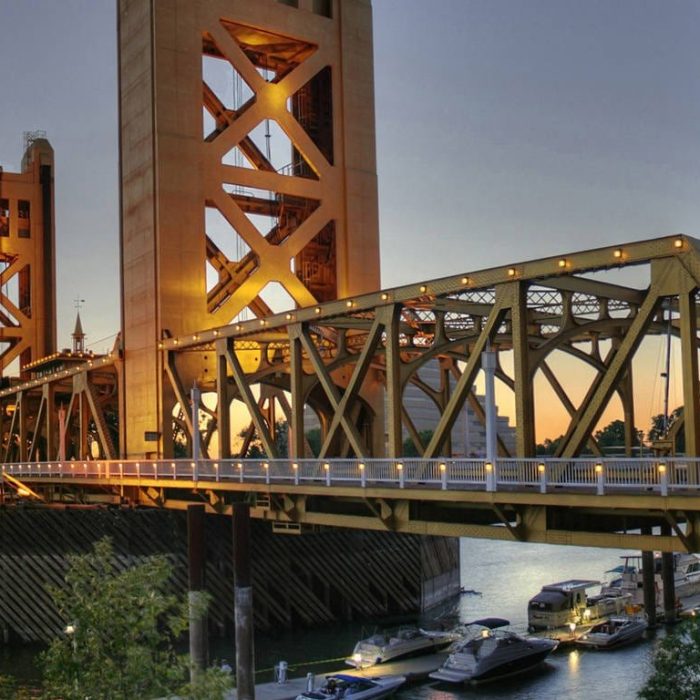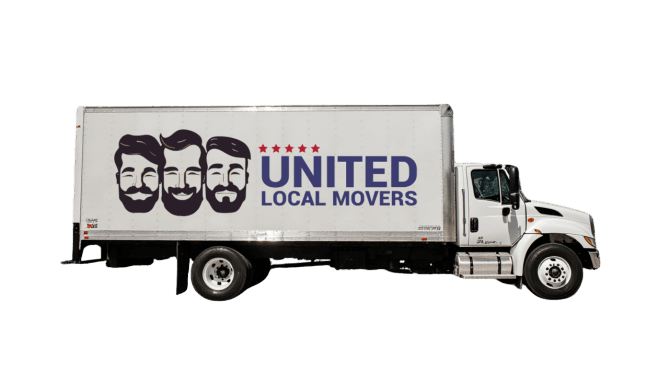Home > Interstate Moving > Moving to California > Moving to Sacramento
Moving to Sacramento
Sacramento, California, may not always make headlines like San Francisco or Los Angeles, but it’s one of the fastest-growing and most livable cities in the state. With a population of about 530,000 in the city and over 2.4 million in the metropolitan area, Sacramento combines the benefits of a capital city with the comfort of suburban neighborhoods and proximity to both mountains and coast.
Known as the “City of Trees” and “America’s Farm-to-Fork Capital,” Sacramento offers a unique lifestyle that blends California’s progressive energy with affordability that’s rare in the state. With the Sierra Nevada mountains just two hours away, Napa Valley nearby, and San Francisco within driving distance, the city’s location is one of its strongest assets.
For people moving to California but daunted by the costs of the Bay Area, Sacramento has become a popular alternative. It offers good schools, a diverse economy, cultural institutions, and a sense of community that larger California cities sometimes lack. But like any place, it comes with challenges — from hot summers to a competitive housing market.

Why More People Are Moving from Other States to Sacramento
Sacramento has become one of the top destinations for Californians relocating from expensive areas like San Francisco, Oakland, or San Jose, as well as newcomers from other states. The number one reason is affordability. While Sacramento is not cheap by national standards, housing costs are significantly lower than in the Bay Area. This allows families to buy larger homes or enjoy more space without leaving California altogether.
The city’s job market is another draw. As the state capital, Sacramento is the heart of California’s government operations, employing tens of thousands in public administration. Beyond government, healthcare is a major employer, with UC Davis Medical Center and Sutter Health providing thousands of jobs. The tech sector is growing too, as companies seek lower operating costs compared to Silicon Valley.
Lifestyle plays a big role as well. Sacramento’s reputation as the “Farm-to-Fork Capital” isn’t just marketing — the city is surrounded by farmland that supplies some of the freshest produce in the country. Farmers markets, local wineries, and a thriving restaurant scene give Sacramento a foodie-friendly culture that rivals bigger cities.
The outdoors are another reason newcomers choose Sacramento. The American and Sacramento rivers run through the city, offering kayaking, boating, and fishing. Lake Tahoe is two hours away for skiing and hiking, while the Pacific Ocean is close enough for weekend beach trips. Sacramento offers access to the best of Northern California’s landscapes without the Bay Area’s density.
Pros of Living in Sacramento
Sacramento’s biggest pro is its balance between affordability and California lifestyle. Housing prices are lower than in San Francisco or Los Angeles, allowing more people to own homes or rent spacious apartments. For families, this is a huge benefit compared to the smaller, pricier options in coastal cities.
Another advantage is Sacramento’s location. The city sits at the junction of major highways and rail lines, making it a transportation hub. You can be in San Francisco in under two hours, reach Napa Valley wineries in an hour, or head to Lake Tahoe for a weekend ski trip. Few cities offer that kind of access to so many destinations.
Diversity is another strong point. Sacramento has been ranked as one of the most diverse cities in the U.S. Its multicultural population brings with it a variety of cuisines, festivals, and traditions that enrich daily life.
The city’s green spaces also stand out. Sacramento lives up to its nickname “City of Trees” with shady boulevards, extensive parks, and riverfront trails. This creates a more relaxed, suburban feel despite being a capital city. Combined with a slower pace than San Francisco or LA, Sacramento offers an appealing quality of life.

Ready to get moved? Get a FREE quote now
Book your move easily and stress-free!
Cons of Living in Sacramento
Sacramento isn’t without its downsides. The most obvious is the summer heat. Temperatures often climb above 100°F in July and August, making air conditioning a necessity and outdoor activities less comfortable. For those used to cooler climates, this can be a major adjustment.
Traffic is another issue. While not as infamous as Los Angeles, congestion has increased as the population has grown. Public transit exists but is limited, and many neighborhoods are car-dependent. For commuters, this can be frustrating.
Another challenge is crime. Certain neighborhoods in Sacramento report higher crime rates, and while the city overall is safer than some larger California metros, it’s important for newcomers to research areas before choosing where to live.
Lastly, while Sacramento is more affordable than coastal California cities, it is still expensive compared to national averages. Housing prices have risen significantly in the past decade, and everyday costs like groceries and utilities are higher than in much of the U.S.

What Life is Like in Sacramento
Life in Sacramento combines the feel of a capital city with a down-to-earth community vibe. On weekdays, government buildings buzz with political activity, while weekends bring families to the rivers, trails, and local breweries. The city’s calendar is filled with cultural events, from the California State Fair to the Farm-to-Fork Festival, celebrating the region’s agricultural roots.
Neighborhoods shape daily life. Midtown is popular among young professionals for its walkability, nightlife, and arts scene. East Sacramento is known for its charming bungalows and tree-lined streets, while Natomas attracts families with its newer homes and schools. Downtown combines historic architecture with new development, making it a hub for work and entertainment.
Sacramento is also a sports town. The Sacramento Kings (NBA) play at the Golden 1 Center downtown, bringing excitement to the city every season. Minor league baseball and soccer add to the mix, while outdoor sports like cycling, kayaking, and running thrive thanks to the city’s rivers and trails.
The food culture is another highlight. Sacramento’s farm-to-table restaurants, craft breweries, and coffee shops reflect its agricultural heart. Eating out here often means meals made with ingredients sourced within 100 miles. This creates a culture of freshness and sustainability that locals are proud of.
Living Costs in Sacramento
Sacramento’s cost of living is high compared to the national average but lower than coastal California cities. Housing remains the biggest expense, but residents find more space for their money than in San Francisco or Los Angeles.
| Category | Sacramento | National Average |
|---|---|---|
| Housing (Rent per Month) | $2,100 | $1,570 |
| Utilities | $200 | $180 |
| Groceries | $370 | $330 |
| Transportation | $170 | $140 |
| Healthcare | $450 | $440 |
While salaries in government and healthcare tend to be stable, newcomers should budget carefully. Many residents save by living in suburbs like Elk Grove or Roseville, where housing is slightly cheaper but commutes are longer.

Ready to get moved? Get a FREE quote now
Ready to get moved? Get a FREE quote now
Schools and Education in Sacramento
Sacramento offers a wide range of educational options. The Sacramento City Unified School District serves much of the city, while neighboring districts like Natomas Unified and Elk Grove Unified cover surrounding areas. Schools vary in quality, with some excelling in academics and extracurriculars while others face challenges with funding and test scores.
Charter schools and magnet programs provide alternatives, and private schools like Jesuit High School and St. Francis High School are popular choices for families seeking different environments.
Higher education is a major asset. California State University, Sacramento (Sac State) enrolls more than 30,000 students and is known for strong programs in business, nursing, and education. The University of California, Davis — one of the top public universities in the country — is just 20 minutes away and offers world-class research and medical programs.
Community colleges like American River College and Sacramento City College provide affordable pathways to higher education, and many transfer students move on to UC or CSU campuses. Combined, these institutions make Sacramento a strong educational hub for students of all ages.
Transportation and Getting Around
Sacramento is a car-friendly city, but it also has a growing public transit system. The Sacramento Regional Transit District operates buses and light rail, connecting downtown with suburbs like Folsom and Elk Grove. While not as extensive as transit systems in larger cities, it provides options for commuters.
Cycling is popular thanks to flat terrain and bike-friendly trails like the American River Parkway. Walking is easy in neighborhoods like Midtown and Downtown, where shops, cafes, and offices are close together.
For long-distance travel, Sacramento International Airport offers direct flights to major U.S. cities and limited international routes. Its size makes it more convenient than larger airports, with shorter security lines and easy access from the city.
Highways I-5 and I-80 connect Sacramento to the rest of California, making trips to San Francisco, Tahoe, or Reno straightforward. While traffic exists, it’s generally less intense than in Los Angeles or the Bay Area.

United Local Movers: Our Services
Relocating to Sacramento doesn’t need to be stressful. United Local Movers specializes in making moves efficient and worry-free. Whether you’re relocating from across California or from another state, our team provides professional packing, secure storage, and safe transportation.
We know Sacramento’s neighborhoods — from historic homes in East Sacramento to new builds in Natomas — and understand the logistics of moving in a growing city. With transparent pricing and tailored services, we help families, students, and professionals transition smoothly into their new homes.
Choosing United Local Movers means choosing reliability, experience, and peace of mind.
Average Cost to Move to Sacramento
Moving costs vary by distance and home size. Local moves in Sacramento usually range from $1,000 to $2,200, while long-distance relocations can cost $3,000 to $6,500.
| Move Type | Estimated Cost |
|---|---|
| Local Move (1-2 Bedrooms) | $1,000–$2,200 |
| Cross-Country Move | $3,000–$6,500 |
| Full Packing Services | + $400–$800 |
| Storage Options | $140–$300 per month |
With United Local Movers, you get accurate quotes and clear communication, ensuring no hidden costs.


How to Choose the Right Moving Company
When moving to Sacramento, it’s important to pick movers with local expertise and a reputation for reliability. Check that the company has proper licensing and insurance, and always ask for a written estimate. Transparency is key — avoid companies with vague quotes or hidden fees.
Look for movers experienced with different housing types, from downtown apartments to suburban homes. United Local Movers combines knowledge of California’s housing market with national moving capabilities, making it a trusted choice for both local and long-distance relocations.
Final Thoughts
Sacramento offers a rare combination of affordability, culture, and California lifestyle. Its location between the Bay Area, Tahoe, and Napa makes it one of the most strategically placed cities in the state. While it faces challenges like hot summers and rising housing costs, it provides a more accessible path to living in California without the overwhelming expenses of coastal metros.
For families, students, and professionals, Sacramento is a city on the rise — rooted in history but embracing growth and diversity. And with United Local Movers, the transition to Sacramento can be smooth, professional, and stress-free.




